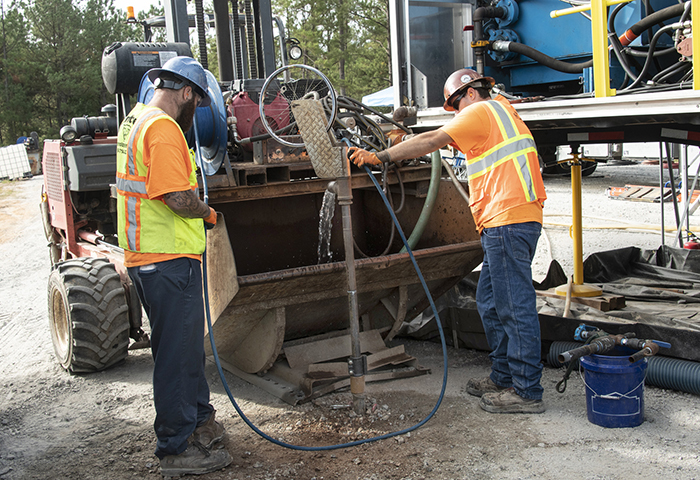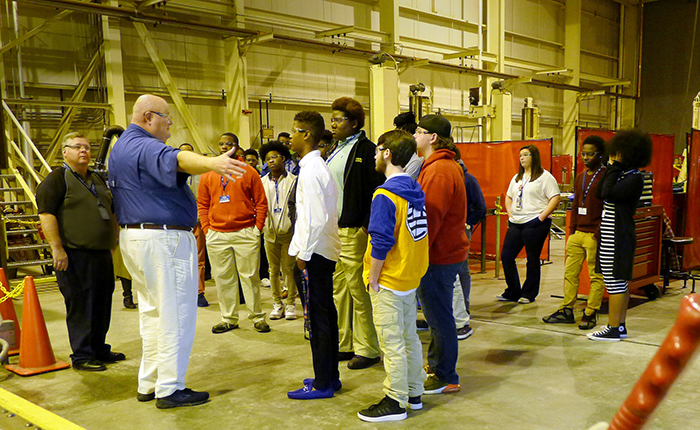 Injecting material containing iron filings into wells at the Savannah River Site is a multi-step process. A well is flushed with water, shown here, before workers add the iron filings to it. The workers injected the iron filings into 22 wells to create a long and continuous iron wall that acts as a giant metal filter of contaminated groundwater.
AIKEN, S.C. – EM workers recently finished constructing a large underground, water-permeable wall made of recycled iron filings that neutralize Cold War-era chemical solvents found in the aquifer beneath the Savannah River Site.
The wall is as long as three basketball courts and, on average, about four inches thick, extending 135 feet below the earth’s surface at its deepest point.
Subcontractors to EM contractor Savannah River Nuclear Solutions (SRNS) mixed large amounts of a food-grade, starch-like material with 1.5 million pounds of iron filings, which are ground-up iron parts from reclaimed automobile engines. The workers then injected the material into 22 wells above the aquifer.
“Incredibly, the weight of this reactive permeable wall is equal to approximately 500 Toyota Prius vehicles and acts much like a giant water filter to remove degreasing solvents like those used at dry-cleaning stores,” said Mark Amidon, a geologist with Savannah River National Laboratory. “The iron causes the physical structure of the solvents to break down into a harmless material. The solvents are completely destroyed.”
 |
|
Workers mixed more than a million pounds of iron filings with a food-grade, starch-like material, shown here. |
The environmental cleanup system is designed to work for decades with routine monitoring and has proven effective elsewhere in the U.S.
“Precision placement at greater depths enabled us to intercept the contaminated groundwater in a narrow zone as it travels along an old, subsurface stream bed channel,” said Seth Miller, an SRNS project manager. “It’s quite an accomplishment.”
Philip Prater, senior physical scientist with the DOE-Savannah River Operations Office, noted workers safely completed the iron injections ahead of schedule.
“SRNS personnel were able to recognize early on and take advantage of cooler air temperatures. The cooler weather greatly improved the volume of iron injected each day,” Prater said. “Further, they ensured excess iron was distributed where groundwater contaminant levels were the highest, which provided improved remedial effectiveness.”
In the Cold War era, solvents were used to decontaminate items or prepare equipment for repair. Over time, the solvents seeped into the subsurface, contaminating the aquifer.
-Contributor: DT Townsend
 Hanford’s 222-S Laboratory recently received the National Safety Council’s Safety Leadership Award for achieving more than five consecutive years without a recordable or lost-workday injury. Pictured are employees of EM Office of River Protection tank farms contractor Washington River Protection Solutions, which manages the laboratory.
RICHLAND, Wash. – The National Safety Council recently awarded the EM Hanford Site’s 222-S Laboratory the Safety Leadership Award for achieving more than five consecutive years without a recordable or lost-workday injury.
The award was given to tank operations contractor Washington River Protection Solutions (WRPS). A recordable injury is any work-related injury that results in medical treatment beyond first aid.
“The work done at the 222-S lab is very important, as the lab handles highly radioactive samples for analysis,” said Richard Valle, tank farms program manager with EM’s Office of River Protection. “Building a safety culture begins with a well-trained workforce. Being able to do it for more than five years in a row without an issue is a testament to the safety mindset of the team.” Don Hardy, WRPS laboratory manager, said the award is an honor truly deserved by the laboratory staff.
“Accomplishments like this only happen when the entire team buys into the concept that workplace safety is a culture that is embedded in everything we do,” Hardy said.
The laboratory is a 70,000-square-foot full-service analytical facility that handles samples for purposes of organic, inorganic, and radio-chemistry analyses. The laboratory complex contains more than 100 pieces of analytical equipment, 156 fume hoods, and 46 manipulators to perform work. Similar to the operation and play of a claw crane game, manipulators allow workers to extend the dexterity of human hands into an often-hazardous environment, improving safety by allowing them to conduct work remotely.
The laboratory has many roles, which include testing of waste compatibility and physical characteristics to support tank-to-tank waste transfers, and performing corrosion rate studies and chemical testing to support tank corrosion inhibition.
The council is a nonprofit organization whose mission is to eliminate preventable deaths at work, in homes and communities, and on the road through leadership, research, education, and advocacy.
-Contributor: Jack Donnelly
 Chip Jenison, Savannah River Nuclear Solutions mechanical shops manager, describes the day-to-day work of a maintenance mechanic to students from the Richmond County School System during their tour of the Savannah River Site.
AIKEN, S.C. – Georgia high school students who take part in a program to equip them with technical occupational skills recently toured EM maintenance facilities at the Savannah River Site (SRS).
Students from 11 high schools in the Richmond County School System participate in the Career, Technical and Agricultural Education Program. Twenty of those students visited SRS, where they listened to presentations about working at the site and toured two large buildings housing maintenance equipment, machinery, and personnel.
“We need to recruit the next generation of personnel who will be responsible for maintaining our facilities and keep the site operating for decades to come,” said Dennis Cheeks, site functional maintenance manager with EM contractor Savannah River Nuclear Solutions (SRNS). “For this tour, we brought in high school students to spark an interest in a career path where they can use their technical skills and to show them various job opportunities available at SRS.”
Employees encouraged the students to obtain degrees from local technical school programs that could help them get hired at the site. Those programs include welding, nuclear operations, radiation control, and electronic and mechanical maintenance.
Taylor Williams, with the SRNS security maintenance division, told the students about her experience earning an electrical and computer engineering technology degree from Augusta Technical College. Williams, an electrical and instrumentation mechanic, also talked about her career at SRS over the past 18 months.
“You can earn a very good living here while pursuing a rewarding career,” Williams told the students. “I’ve really enjoyed my time at SRS; you can too.”
Cheeks noted that Williams can advance to new positions at SRS, such as a specialist, process analyst, engineering role, or supervisor.
The employees at SRS and the students also weighed the benefits of degrees from two-year technical colleges and four-year colleges, and the importance of an effective resume and practical interview skills.
-Contributor: DT Townsend
|